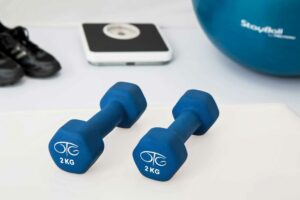First off, exercise is good for us. Among the many benefits, exercise helps our mental well-being, strengthens bones, muscle and joints, improves the health of our heart and lungs, improves coordination and balance and helps us to maintain a healthy body weight.
However, like with many things in life, you can do too much, and it is possible to cause pain, injury or other mental and physical ill health. Maintaining high levels of exercise for sustained periods of time without time to recover is not advisable and increasing levels of exercise too quickly can often end in a negative outcome.
Things like osteoarthritis, back pain, plantar fascia pain, hip pain and tendonitis can all be made better, or worse with exercise. It’s not easy to know what to do.
So, with all this time on our hands that we have never had before it begs the questions; ‘how much exercise should I be doing?’ ‘What should I be doing?’ and ‘How should I be increasing’.

Note – more than 60 minutes a day provides additional health benefits and this time can be accumulated over the course of the day.
· In addition, muscle strengthening activities should be done 2 or more days a week.
· In addition, muscle strengthening activities should be done 2 or more days a week.
So, for adults – 150 minutes of moderate intensity exercise a week PLUS 2 sessions of exercise based on strengthening the major muscle groups.

Technically speaking, moderate intensity exercise is that which burns off 3 – 6 times as much energy than when you are sitting quietly. But that doesn’t really help you in a practical sense!
Moderate intensity exercise is that which noticeably increases your heart rate and may include exercises such as brisk walking, gardening, gentle cycling or moving moderate weights around.
By contrast, vigorous intensity exercise uses large amounts of effort and will result in rapid breathing and significant increase in heart rate. This may include running, climbing a hill, aerobics or a fast cycle.
This is a tricky question. If you called and asked me how to get to clinic, you would expect my first response to be; ‘Where are you coming from?’. This is no difference to know where you start – we need to know where you are coming from.
Everyone has a different level of fitness and tolerance to exercise. What may be easy to complete for one person may be very difficult for another. It’s really difficult to give a response that is relevant to everyone.
So my advice is START SLOW.
If you are going to go for a run, why not use out return to running guide? It gradually eases you into running and also guides you on how to progress.
If you are following an online video, take your time with it. You may need to do small amounts at a time and take regular breaks, don’t feel like you need to complete the workout like the ‘superfit’ instructor who has been doing it for years on the screen.
For muscle strengthening exercises, I would suggest starting with just bodyweight exercise, and focus on the major muscle groups by using ‘compound movements’ such as squats, lunges, push ups and deadlifts to work the major muscle groups.
Ultimately remember the saying; ‘Rome wasn’t built in a day’, start slow and gradually build up. It’s normal to be a bit achy the day after exercise too, so don’t worry too much about the muscular aches and pains to start with unless they last more than 3 days or if you see significant swelling/deformities in the body.

This is such a good question and is different depending on who you speak to. Ask yoga teacher and the answer will be ‘yoga’, ask a runner and they will say ‘running’, pilates teachers say ‘pilates’, cyclists say cycling and gym instructors say ‘lifting weights’ (apologies to all these groups but I’m sure you see the point I’m making).
However, there are many misconceptions about exercise such as ‘high impact exercise ruins your joints’, ‘lifting weights makes you too bulky’ and ‘swimming is the best exercise’ (I’m amazed how often I hear that, and still don’t really know what the phrase means!!!). These are not statements supported by literature. There is not a ‘best and worst’ – and variety/cross training is probably quite important.
My view, if you want it? – Start with low impact exercises if you are new to exercises as it will take some time to build a tolerance to impact. Gradually build higher impact exercise like running and jumping into your plan as you feel able. The biggest advice though is DO SOMETHING YOU LIKE. Don’t pick the boring exercise because everyone says you should be doing it – you are unlikely to do it for a long time, so pick something you fin enjoyable and it’s more likely to be a long term change.
I don’t want to be accused on advising you to go against government guidance, and I believe strongly that as a health care professional it is important that I set a good example to the local community on looking after or health.
It is however, really important that we do get outside a bit. If you are lucky enough to have a garden then even doing exercise there. However, we are currently (at the time or writing this) permitted to go out for a form of exercise once a day, and we should take advantage of this. We shouldn’t underestimate how important the fresh air and different scenery is on our mental health. Just do it on your own – don’t join up with your mates or the local running group to go!
I hope that has been helpful in a physios perspective on exercise and that you find it of benefit in planning and sticking to an exercise plan. If you have any questions please feel free to message me at josh@reflex18.co.uk. Here are my 3 main points:
3. Pick exercise you enjoy – it will last longer
